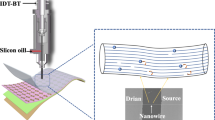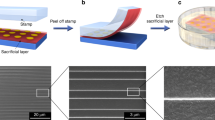Abstract
Printing is an emerging approach for low-cost, large-area manufacturing of electronic circuits, but it has the disadvantages of poor resolution, large overlap capacitances, and film thickness limitations, resulting in slow circuit speeds and high operating voltages. Here, we demonstrate a self-aligned printing approach that allows downscaling of printed organic thin-film transistors to channel lengths of 100–400 nm. The use of a crosslinkable polymer gate dielectric with 30–50 nm thickness ensures that basic scaling requirements are fulfilled and that operating voltages are below 5 V. The device architecture minimizes contact resistance effects, enabling clean scaling of transistor current with channel length. A self-aligned gate configuration minimizes parasitic overlap capacitance to values as low as 0.2–0.6 pF mm−1, and allows transition frequencies of fT = 1.6 MHz to be reached. Our self-aligned process provides a way to improve the performance of printed organic transistor circuits by downscaling, while remaining compatible with the requirements of large-area, flexible electronics manufacturing.
This is a preview of subscription content, access via your institution
Access options
Subscribe to this journal
Receive 12 print issues and online access
$259.00 per year
only $21.58 per issue
Buy this article
- Purchase on Springer Link
- Instant access to full article PDF
Prices may be subject to local taxes which are calculated during checkout




Similar content being viewed by others
References
Sanderson, K. Display of flexibility. Nature 445, 473 (2007).
Ong, B. S., Wu, Y. L., Liu, P. & Gardner, S. High-performance semiconducting polythiophenes for organic thin-film transistors. J. Am. Chem. Soc. 126, 3378–3379 (2004).
Heeney, M. et al. Stable polythiophene semiconductors incorporating thieno[2,3-b]thiophene. J. Am. Chem. Soc. 127, 1078–1079 (2005).
McCulloch, I. et al. Liquid-crystalline semiconducting polymers with high charge-carrier mobility. Nature Mater. 5, 328–333 (2006).
Fix, W., Ullmann, A., Ficker, J. & Clemens, W. Fast polymer integrated circuits. Appl. Phys. Lett. 81, 1735–1737 (2002).
Steudel, S. et al. Comparison of organic diode structures regarding high-frequency rectification behavior in radio-frequency identification tags. J. Appl. Phys. 99, 114519 (2006).
Sirringhaus, H. et al. High-resolution inkjet printing of all-polymer transistor circuits. Science 290, 2123–2126 (2000).
Zielke, D. et al. Polymer-based organic field-effect transistor using offset printed source/drain structures. Appl. Phys. Lett. 87, 123508 (2005).
Knobloch, A., Manuelli, A., Bernds, A. & Clemens, W. Fully printed integrated circuits from solution processable polymers. J. Appl. Phys. 96, 2286–2291 (2004).
Weste, N. H. E. & Harris, D. CMOS VLSI Design, Ch. 1 (Pearson Education, Boston, 2005).
Sze, S. M. Physics of Semiconductor Devices, Ch. 8 (John Wiley & Sons, New York, 1981).
Sele, C. W., von Werne, T., Friend, R. H. & Sirringhaus, H. Lithography-free, self-aligned inkjet printing with sub-hundred-nanometer resolution. Adv. Mater. 17, 997–1001 (2005).
Austin, M. D. & Chou, S. Y. Fabrication of 70 nm channel length polymer organic thin-film transistors using nanoimprint lithography. Appl. Phys. Lett. 81, 4431–4433 (2002).
Zhao, N. et al. Self-aligned inkjet printing of highly conducting gold electrodes with submicron resolution. J. Appl. Phys. 101, 064513 (2007).
Chua, L. L. et al. General observation of n-type field-effect behaviour in organic semiconductors. Nature 434, 194–199 (2005).
Yoon, M. H., Yan, H., Facchetti, A. & Marks, T. J. Low-voltage organic field-effect transistors and inverters enabled by ultrathin cross-linked polymers as gate dielectrics. J. Am. Chem. Soc. 127, 10388–10395 (2005).
Jang, Y. et al. Low-voltage and high-field-effect mobility organic transistors with a polymer insulator. Appl. Phys. Lett. 88, 072101 (2006).
Yang, S. Y., Kim, S. H., Shin, K., Jeon, H. & Park, C. E. Low-voltage pentacene field-effect transistors with ultrathin polymer gate dielectrics. Appl. Phys. Lett. 88, 173507 (2006).
Frank, D. J. et al. Device scaling limits of Si MOSFETs and their application dependencies. Proc. IEEE 89, 259–288 (2001).
Tulevski, G. S., Nuckolls, C., Afzali, A., Graham, T. O. & Kagan, C. R. Device scaling in sub-100 nm pentacene field-effect transistors. Appl. Phys. Lett. 89, 183101 (2006).
Shur, M., Hack, M. & Shaw, J. G. A new analytic model for amorphous-silicon thin-film transistors. J. Appl. Phys. 66, 3371–3380 (1989).
Campbell, I. H. et al. Controlling Schottky energy barriers in organic electronic devices using self-assembled monolayers. Phys. Rev. B 54, 14321–14324 (1996).
de Boer, B., Hadipour, A., Mandoc, M. M., van Woudenbergh, T. & Blom, P. W. M. Tuning of metal work functions with self-assembled monolayers. Adv. Mater. 17, 621–625 (2005).
Ashkenasy, G., Cahen, D., Cohen, R., Shanzer, A. & Vilan, A. Molecular engineering of semiconductor surfaces and devices. Acc. Chem. Res. 35, 121–128 (2002).
Tulevski, G. S. et al. Chemical complementarity in the contacts for nanoscale organic field-effect transistors. J. Am. Chem. Soc. 128, 1788–1789 (2006).
Maitra, K. & Bhat, N. Impact of gate-to-source/drain overlap length on 80-nm CMOS circuit performance. IEEE Trans. Electron. Devices 51, 409–414 (2004).
Chiang, C. S. et al. Top-gate staggered amorphous silicon thin-film transistors: Series resistance and nitride thickness effects. Jpn J. Appl. Phys. 37, 5914–5920 (1998).
Shaw, J. M., Gelorme, J. D., LaBianca, N. C., Conley, W. E. & Holmes, S. J. Negative photoresists for optical lithography. IBM J. Res. Dev. 41, 81–94 (1997).
Burgi, L., Richards, T. J., Friend, R. H. & Sirringhaus, H. Close look at charge carrier injection in polymer field-effect transistors. J. Appl. Phys. 94, 6129–6137 (2003).
Wagner, V., Wobkenberg, P., Hoppe, A. & Seekamp, J. Megahertz operation of organic field-effect transistors based on poly(3-hexylthiopene). Appl. Phys. Lett. 89, 243515 (2006).
Acknowledgements
The research was supported by the Engineering and Physical Sciences Research Council (EPSRC) and the EU Integrated Project NAIMO (No NMP4-CT-2004-500355). The authors thank the Dow Chemical Company and Merck for providing F8T2 and pBTTT, D.J. Stokes (FEI Company) for FIB-SEM measurement, A. Facchetti (Northwestern University) for helpful discussions, R. Peterson (Cavendish Laboratory) for inverter measurements, X. Cheng (Cavendish Laboratory) for helpful support, and M. Tello (Cavendish Laboratory) for performing the Kelvin probe work function measurements.
Author information
Authors and Affiliations
Contributions
Y.Y.N. and H.S. conceived and designed the experiments. Y.Y.N. performed the experiments. N.Z. contributed to self-aligned inkjet printing. M.C. measured the transition frequency of transistors. Y.Y.N. and H.S. analysed the data and co-wrote the paper.
Corresponding author
Ethics declarations
Competing interests
H.S. and Y.Y.N. have filed a patent application on the process described in this work.
Supplementary information
Supplementary Information
Supplementary information and figures S1–S5 (PDF 186 kb)
Rights and permissions
About this article
Cite this article
Noh, YY., Zhao, N., Caironi, M. et al. Downscaling of self-aligned, all-printed polymer thin-film transistors. Nature Nanotech 2, 784–789 (2007). https://doi.org/10.1038/nnano.2007.365
Received:
Accepted:
Published:
Issue Date:
DOI: https://doi.org/10.1038/nnano.2007.365
This article is cited by
-
Foundry-compatible high-resolution patterning of vertically phase-separated semiconducting films for ultraflexible organic electronics
Nature Communications (2021)
-
Vertical organic permeable dual-base transistors for logic circuits
Nature Communications (2020)
-
Rapid and high-resolution patterning of microstructure and composition in organic semiconductors using ‘molecular gates’
Nature Communications (2020)
-
Bending reliability of screen-printed vias for a flexible energy module
npj Flexible Electronics (2020)
-
Non-dimensional groups for electrospray modes of highly conductive and viscous nanoparticle suspensions
Scientific Reports (2020)



